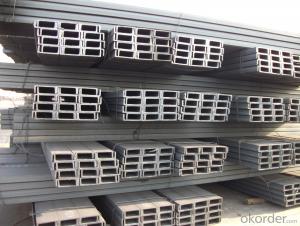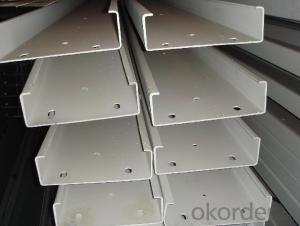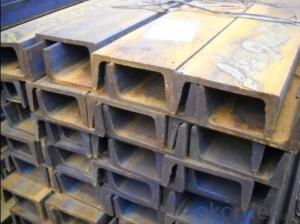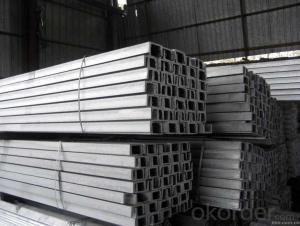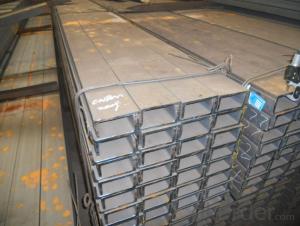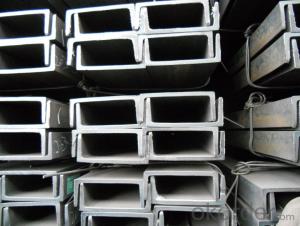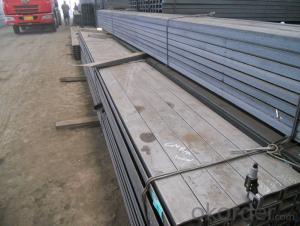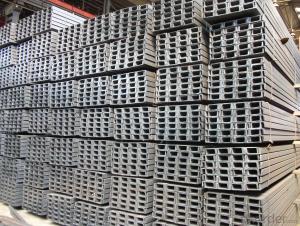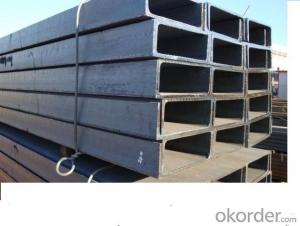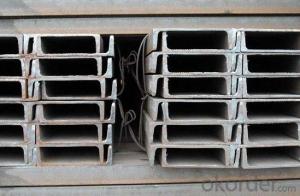High Quality 20# Steel Channel
- Loading Port:
- China Main Port
- Payment Terms:
- TT OR LC
- Min Order Qty:
- -
- Supply Capability:
- -
OKorder Service Pledge
OKorder Financial Service
You Might Also Like
Steel Channel
Standard: GB
Material: Q235
Length: 6m, 12m
Size:
| Size (mm) | Mass (Kg/m) |
| 200*73*7.0 | 22.637 |
| 200*75*9.0 | 25.777 |
The chemical composition of HR Channel Steel according to Q235B is shown in Table-1.
Alloy No | Grade | Element(%) | ||||
C | Mn | S | P | Si | ||
Q235 | B | 0.12-0.20 | 0.3-0.7 | ≦0.045 | ≦0.045 | ≦0.3 |
Table-1
Note: we are able to present our customers relevant SGS test report for chemical composition of HR Channel Steel.
The mechanical property of HR Channel Steel according to Q235B is shown in Table-2
Alloy No | Grade | Yielding Strength Point(Mpa) | |||
Thickness(mm) | |||||
≦16 | >16-40 | >40-60 | >60-100 | ||
≧ | |||||
Q235 | B | 235 | 225 | 215 | 205 |
Table-2
Package & Delivery of MS Channel:
1.The hot rolled channel steel will be packed in bundle with steel wire at each end of every bundle and color marking in order to help the customer to recognize his goods more easily at sight.
2. And the hot rolled channel steel could be loaded into 20ft or 40ft container, or by bulk cargo.If the weight of each bundle reaches more than 3.5 mt, the loading by break bulk cargo should be choosed.When the weight of each bundle reaches less than 3mt, the loading by container should be choosed.
3.As for the transportaion from mill to loading port, the truck will be usually used. And the maximum quantity for each truck is 40mt.
4.All in all, we could do in accordance with customer's request.
*If you would like to get our price, please inform us the size, standard/material and quantity. Thank you very much for your attention.
- Q: What are the factors that affect the price of steel channels?
- The price of steel channels can be influenced by various factors. Let's explore some of these factors: 1. Raw material costs play a significant role in determining the price of steel channels. The cost of materials like steel, iron ore, and coal directly affects the manufacturing cost of steel channels. Fluctuations in these raw material prices can, in turn, impact the final price of the channels. 2. Supply and demand dynamics also have an impact on steel channel prices. When demand for steel channels is high and the supply is limited, prices tend to rise. Conversely, if demand is low and there is excess supply, prices are likely to decrease. 3. Manufacturing and processing costs, including expenses related to labor, energy, and equipment, can influence the price of steel channels. Higher manufacturing costs may result in higher prices for the channels. 4. The level of competition among steel channel manufacturers can also affect prices. When multiple producers offer similar products, they may engage in price competition to attract customers, leading to lower prices. On the other hand, if there are fewer suppliers or if they offer unique products, prices may be higher. 5. Transportation and logistics costs can impact the final price of steel channels. Factors such as fuel prices, shipping distances, and transportation infrastructure all contribute to transportation costs, which can be passed on to the buyer. 6. Government regulations and tariffs are another factor that can influence steel channel prices. Trade policies, import duties, and government regulations can increase the price of imported steel channels, while subsidies or support from the government can lead to lower prices. 7. Economic conditions, both globally and domestically, have an impact on steel channel prices. Economic growth, inflation, and currency exchange rates can all influence the cost of steel channels. It is important to understand that these factors are interconnected and can vary depending on market dynamics and location. Therefore, buyers and sellers in the steel channel industry must consider these factors and their potential impact.
- Q: What about channel 16?
- Waist height of 160mm channel (channel number usually take ten is waist high), 160*63*6.5 and 160*65*8.5 two models, respectively, 160a# and 160b#, the general situation is not specified, with a, B that kind of time, usually 160a#.
- Q: Can steel channels be used in industrial applications?
- Absolutely, steel channels are an excellent choice for industrial applications. These versatile structural components are widely used in various industries because of their exceptional strength, durability, and ability to bear heavy loads. In industrial settings, they are frequently employed to provide support for heavy loads, ensure structural stability, and construct frameworks for machinery, equipment, and infrastructure. Additionally, steel channels find extensive use in industries such as construction, manufacturing, engineering, and transportation. They are utilized for diverse applications including building frames, conveyor systems, shelving units, bridges, and support beams. Furthermore, steel channels are highly adaptable and can be easily fabricated, welded, and tailored to meet specific industrial requirements. Consequently, they have become a favored choice for a wide range of industrial applications.
- Q: What are the different shapes of steel channels?
- Steel channels come in a variety of shapes, including C-channel, U-channel, and J-channel. C-channels have a C-shaped profile and are commonly used for structural support in construction. U-channels have a U-shaped profile and are often utilized as framing or edging material. J-channels have a J-shaped profile and are typically employed for trim or finishing purposes, such as around windows or doors.
- Q: What are the considerations for steel channel connections to timber structures?
- There are several important factors to consider when connecting steel channels to timber structures. These factors include the compatibility of materials, load capacity, joint design, and potential for corrosion. The first and most important factor is ensuring that the steel channel and timber are compatible materials. It is necessary to evaluate the mechanical properties of both materials, such as their strength and stiffness. Additionally, any potential chemical reactions between the materials should be taken into account to prevent corrosion or degradation. Another critical consideration is the load capacity of the connection. The steel channel must be capable of supporting the expected loads without compromising the structural integrity of the timber. This requires a thorough analysis of the applied loads, including static and dynamic forces, as well as any potential impact or wind loads. The design of the joint is also crucial for a successful connection. The steel channel must be appropriately sized and positioned to evenly distribute the loads across the timber members. This may involve using suitable fasteners, such as bolts or screws, and ensuring that they are correctly installed and tightened to achieve the desired level of connection strength. Finally, it is important to carefully evaluate the potential for corrosion. Steel is prone to corrosion when exposed to moisture or chemicals, which can weaken the connection over time. It is necessary to consider proper protective measures, such as galvanizing or coating the steel channel, to prevent corrosion and prolong the lifespan of the connection. In summary, when connecting steel channels to timber structures, it is crucial to consider material compatibility, load capacity, joint design, and corrosion prevention to ensure a safe and long-lasting connection. By addressing these considerations, the connection can effectively transfer loads and maintain the structural integrity of the timber structure.
- Q: Can steel channels be used in interior design applications?
- Certainly, interior design applications can make use of steel channels. With their versatility and durability, steel channels prove to be fitting for various design purposes. They can serve as structural elements, decorative accents, or even functional features within interior spaces. Architectural details, including room dividers, wall paneling, shelving units, and furniture pieces, can creatively incorporate steel channels. By doing so, they lend an industrial and contemporary touch to any interior design style, thanks to their sleek and modern appearance. Moreover, steel channels offer flexibility to interior designers as they can be customized in terms of size, finish, and shape, thus meeting specific design requirements.
- Q: 18# channel perimeter
- You don't know where to use this data, in general, the characteristics of the data channel in section area and theoretical weight, I suggest you refer to GB/T 706-2008 "hot rolled steel", see annex, hoping to help you.
- Q: Can steel channels be used for window framing?
- Indeed, window framing can make use of steel channels. Steel channels possess strength and durability, rendering them suitable for bearing the weight of windows. Moreover, they can bestow additional stability and security to window installations. Furthermore, steel channels exhibit resistance against corrosion, a crucial quality for window frames that confront outdoor elements. On the whole, employing steel channels for window framing has the ability to augment the structural integrity and longevity of windows.
- Q: Is channel steel expensive or angle expensive?
- There is a difference in price for different specifications
- Q: What are the different load-bearing tests conducted on steel channels?
- There are several load-bearing tests that are conducted on steel channels to assess their structural integrity and performance. These tests help determine the maximum load that a steel channel can bear without failure. Some of the different load-bearing tests conducted on steel channels include: 1. Tensile Test: This test measures the maximum tensile strength of the steel channel by applying a gradually increasing axial load until failure occurs. It helps assess the channel's ability to resist pulling or stretching forces. 2. Compression Test: This test determines the maximum compressive strength of the steel channel by applying a gradually increasing axial load until it buckles or collapses. It provides insights into the channel's ability to withstand compressive forces. 3. Bending Test: In this test, the steel channel is subjected to a gradually increasing load applied perpendicular to its length until it reaches its maximum bending capacity. It assesses the channel's resistance to bending or flexural forces. 4. Shear Test: The shear test measures the maximum shear strength of the steel channel by applying a force parallel to its cross-sectional area until it fails. It helps evaluate the channel's ability to withstand shearing forces. 5. Fatigue Test: This test involves subjecting the steel channel to repeated and varying loads over a specified period to simulate real-world usage conditions. It assesses the channel's resistance to fatigue and its ability to withstand cyclic loading. 6. Impact Test: In this test, a sudden and high-velocity load is applied to the steel channel to simulate impact or shock loading. It helps evaluate the channel's ability to absorb and dissipate energy without failure. 7. Buckling Test: This test is conducted to determine the critical load at which the steel channel buckles or collapses due to instability. It helps assess the channel's resistance to buckling under compressive loads. These load-bearing tests are crucial in ensuring the reliability and safety of steel channels in various applications, such as construction, manufacturing, and infrastructure. By conducting these tests, engineers can determine the load limits and performance characteristics of steel channels, allowing for informed design decisions and ensuring structural integrity.
Send your message to us
High Quality 20# Steel Channel
- Loading Port:
- China Main Port
- Payment Terms:
- TT OR LC
- Min Order Qty:
- -
- Supply Capability:
- -
OKorder Service Pledge
OKorder Financial Service
Similar products
Hot products
Hot Searches
Related keywords
